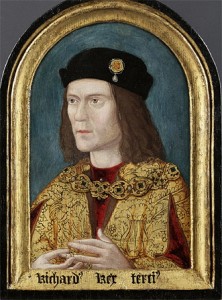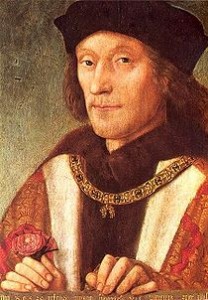 On this day in history, the 22nd August 1485, in rural Leicestershire near Market Bosworth, the armies of King Richard III and Henry Tudor faced each other in a battle that would see the death of the King and the beginning of a new dynasty, the Tudor dynasty, which would have a major impact on English history.
On this day in history, the 22nd August 1485, in rural Leicestershire near Market Bosworth, the armies of King Richard III and Henry Tudor faced each other in a battle that would see the death of the King and the beginning of a new dynasty, the Tudor dynasty, which would have a major impact on English history.
When Henry Tudor challenged the King on that August day, Richard III had been King for just over two years. He had gone from being Lord Protector to the young King Edward V, the 12 year old son of Richard’s brother Edward IV, to being King after Edward IV’s sons were declared illegitimate. His challenger, Henry Tudor, was the son of Edmund Tudor, 1st Earl of Richmond, and Lady Margaret Beaufort, a woman descended from John of Gaunt, third son of Edward III. As a Lancastrian, Henry had fled to Brittany in France, after Edward IV successfully regained the throne from Henry VI in 1471, but returned to England after his mother had conspired with Elizabeth Woodville, Edward IV’s widow, to arrange a marriage between Elizabeth’s daughter, Elizabeth of York, and Henry and to promote Henry as an alternative to Richard III.
In the summer of 1485, Henry made his move. With the support of the French and some English exiles, he sailed from France to Milford Haven on the Welsh coast to declare war on the King. His Welsh heritage enable Henry to gain more support there and to add to his army and when he finally met Richard at Bosworth it is estimated that he had around 5000 men. Henry requested the support of his stepfather, Lord Thomas Stanley, and his step-uncle, Sir William Stanley, who were both wealthy men and could raise large armies to support Henry. The Stanleys, although linked to Henry through Thomas’s marriage to Margaret Beaufort, were actually supporters of the King, so it was not known who they would support on the battlefield. Richard, on hearing of Henry’s landing in Wales, took Thomas Stanley’s eldest son, Lord Strange, hostage in an attempt to ensure that the Stanleys would stay true.
Although Henry had managed to build an army of around 5000 men, Richard’s men, who were marching out from Leicester in an attempt to cut Henry off as he marched from Wales to London, are thought to have numbered around 12000. Richard must have felt confident that he could squash Henry, particularly when they finally met and Henry’s men were struggling to negotiate marshland and Richard’s men were on higher ground! Richard and his army certainly had the advantage, particularly as Henry had no battle experience whatsoever!
 Richard took the initiative and sent the Duke of Norfolk and some men out to attack Henry’s men who had become strung out in a line below them after being forced to circle around the marsh. Fortunately for Henry, he had the Earl of Oxford, an experience soldier on his side, who knew just what to do. Oxford quickly created a wedge of men between two banners and, in the fighting that followed, the Duke of Norfolk was killed – a blow for the King, but he still had a huge army at his disposal. Things looked good for the King until… the Stanleys, who had been watching events unfold but had not committed their armies to any particular side, made a decision. As Richard III’s cavalry clashed with Henry and his men, who had been on their way to appeal to the Stanleys, William Stanley ordered his men to attack the King and his cavalry. Before the Stanleys and their men reached Henry and Richard, Richard’s men managed to kill Henry’s standard bearer, Sir William Brandon (father of Charles Brandon, Duke of Suffolk), and unhorse Sir John Cheyne, but the tide turned when Stanley’s men reached the spot. King Richard III, himself, was killed and Henry Tudor was crowned King Henry VII later that day when Richard’s crown was recovered.
Richard took the initiative and sent the Duke of Norfolk and some men out to attack Henry’s men who had become strung out in a line below them after being forced to circle around the marsh. Fortunately for Henry, he had the Earl of Oxford, an experience soldier on his side, who knew just what to do. Oxford quickly created a wedge of men between two banners and, in the fighting that followed, the Duke of Norfolk was killed – a blow for the King, but he still had a huge army at his disposal. Things looked good for the King until… the Stanleys, who had been watching events unfold but had not committed their armies to any particular side, made a decision. As Richard III’s cavalry clashed with Henry and his men, who had been on their way to appeal to the Stanleys, William Stanley ordered his men to attack the King and his cavalry. Before the Stanleys and their men reached Henry and Richard, Richard’s men managed to kill Henry’s standard bearer, Sir William Brandon (father of Charles Brandon, Duke of Suffolk), and unhorse Sir John Cheyne, but the tide turned when Stanley’s men reached the spot. King Richard III, himself, was killed and Henry Tudor was crowned King Henry VII later that day when Richard’s crown was recovered.
Richard III’s body was recovered from the battlefield and taken to Leicester, where it was displayed for several days before being buried. It is not known exactly where Richard was buried as contemporary reports suggest two different sites, both in Leicester: The Newarke (the Church of the Annunciation of Mary the Virgin) and the Grey Friars monastery. Legend has it that during the dissolution of the monasteries in the time of Henry VIII, Henry VII’s son, Richard’s remains were dug up and thrown in the River Soar, but we just don’t know. It is sad that this King of England’s resting place has been lost.
The new king, Henry VII, secured his claim to the throne by marrying Elizabeth of York on the 18th January 1486, thus uniting the Houses of York and Lancaster and starting a new dynasty: The House of Tudor. The emblem of the Tudor Rose symbolised this union by combining the white rose of York and the red rose of Lancaster. This was the start of a new era, the reign of the Tudors, that iconic family who reigned over England for just 118 years but who have captured the hearts and minds of many people all over the world.
Bosworth Battlefield Heritage Centre
Bosworth Battlefield Heritage Centre and Country Park is well worth a visit if you want to find out more about this historic battle. There, visitors can:-
- Walk the Battle of Bosworth Trail – This trail will enable you to see landmarks such as the actual Battlefield, the church where Richard was said to have heard his last mass on the eve of battle and the new sundial which features the thrones of Richard III, Henry VII and Lord Stanley as well as giving amazing panoramic views of the surrounding countryside.
- Browse the interactive Exhibition – Learn about the battle, Tudor warfare and how archaeologists discovered the true location of the battle.
See “The True Location of the Battle of Bosworth” for more information on how archaeologists have pinpointed the battle site.
Bosworth Battlefield and Our Tours
Attendees on our Executed Queens Tour and Discover the Tudors Tour spend a day at Bosworth Battlefield Heritage Centre and enjoy a private hands-on falconry experience, an entertaining talk on weaponry and life as a soldier (rather bloodthirsty!) and a guided walk of the battlefield trail. We had an amazing day at Bosworth this year and I’m looking forward to going back next year. See our History Tour website for further details on our tours.
Enjoy this slideshow of photos from our visit…
[slideshow id=427 w=400 h=300]
Also on this day in history…
- 1545 – Death of Charles Brandon, Duke of Suffolk, friend of Henry VIII, husband of Mary Tudor Queen of France and grandfather of Lady Jane Grey.
- 1552 – Edward VI visits Christchurch on his royal progress
- 1553 – Execution of John Dudley, Earl of Warwick and Duke of Northumberland, on Tower Hill